
Cedar Gallery
Home
|
Cedar info |
News |
Contact |
![]() Dutch
Dutch
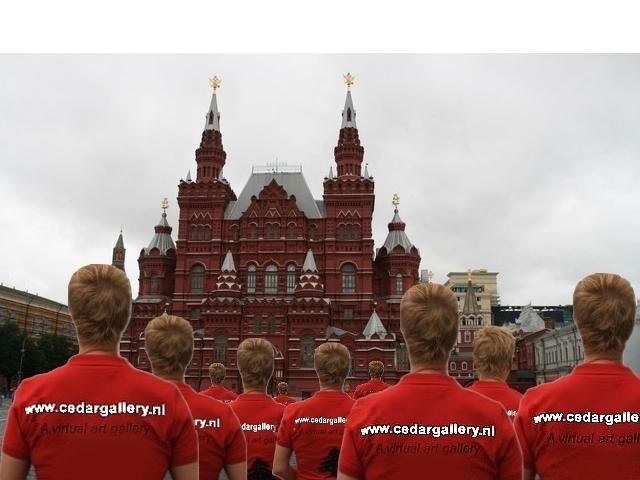

A.W. May 2010
Photo's: Cees & Aly Wagenvoorde
©PAM PHOTOS Delden
©.All Rights Reserved. NO!- Neither Facebook and
Instagram nor any other visitor may use my name or any of my content
without my permission.
You can contact me at
cedars@live.nl
- - - - - - - - - - - - - - - - - - - - - - - - - - - - - - - - - - - -
- - - - - - - - - - - - -
Welcome to Moscow,
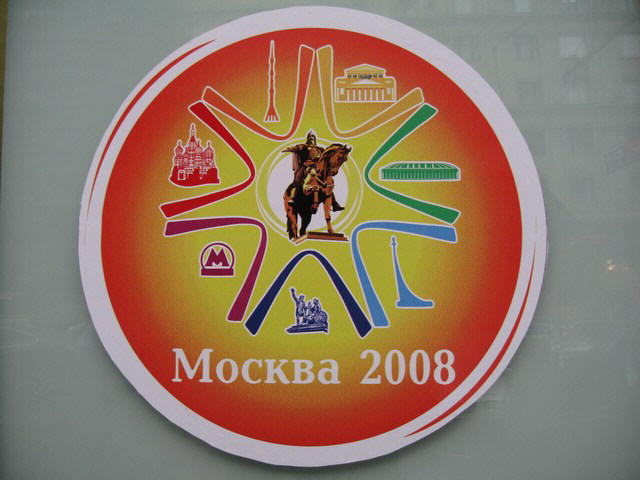 the capital of Russia,
the capital of Russia,
with its impressive metro stations,

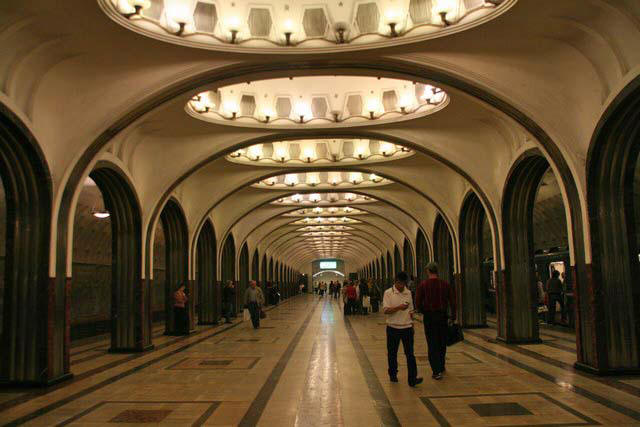
its fountains,
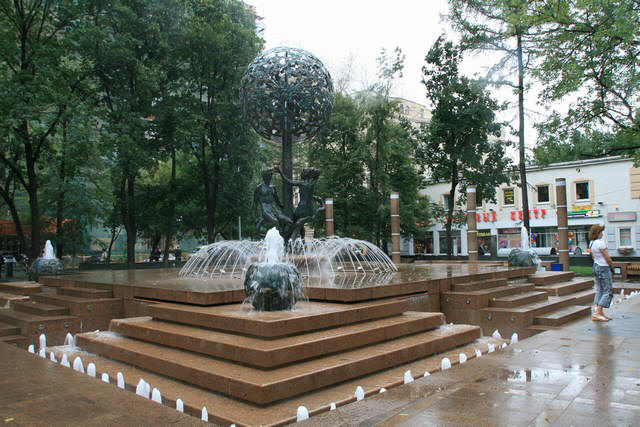
shops and statues, and ...................
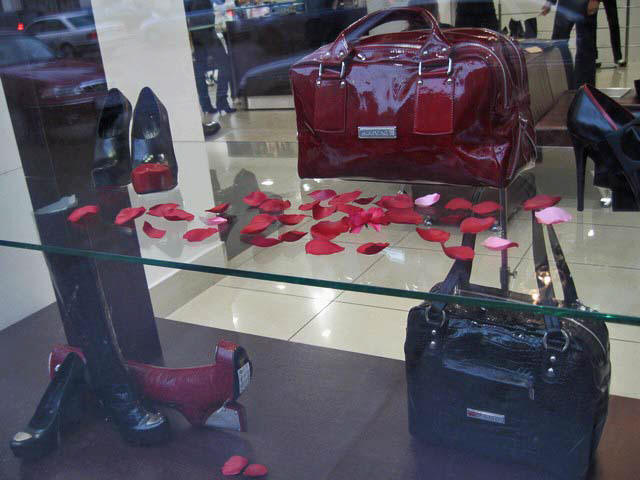

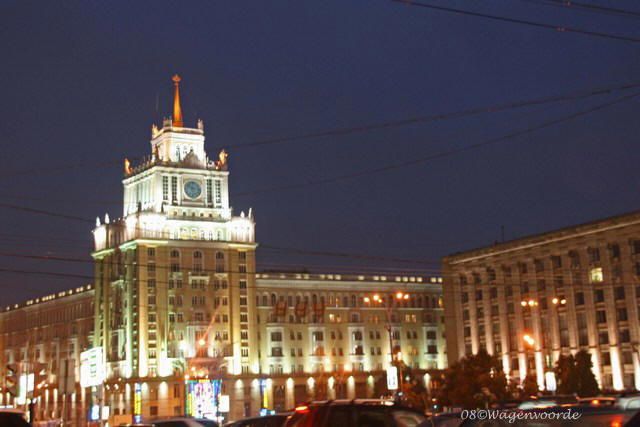
Moscow is the political and business centre of
Russia, as well as the nation’s seat of power and home to its leading
economic and financial institutions.
It is a city in which one comes face to face with all that is finest and
all that is most frustrating in Russia. It is not only an interesting,
and beautiful city, there are also extreme tensions of a city coming to
terms with the confusions of rapid social change. More than anywhere
else in the country, it is in Moscow where the Soviet past collides with
the capitalist future. Lenin's Mausoleum remains intact, but today it
faces the newly chic GUM (pronounced goom).
The most famous places are the Kremlin and the Red
Square.
The Kremlin dates back to 1147 and the very beginnings of Moscow. The
original towered walls were completed in 1157, ten years after Moscow's
founding, and by the late 14th century, Moscow had risen enough in power
and prestige to become the seat of the Russian Orthodox Church. This
change brought with it the construction of some of the Kremlin's most
impressive structures, including the Cathedral of the Assumption, where
Ivan defiantly tore up the charter binding Moscow to Mongol rule. Over
the centuries, almost every ruler added their own, monumental touches to
the ensemble.
For most visitors, Red Square is indelibly associated
with images of stone-faced Soviet leaders standing in the bitter cold,
watching the army. Although the Square is no longer witness to the
imposing parades of May Day, it remains a profoundly impressive space.
Delimited by the stark severity of the mausoleum, the expansive facade
of the world-famous GUM department store, and the exuberant colors of
St. Basil's Cathedral, Red Square is worth a stop for any visitor of
Moscow.
Before going here, many people meet at Zhukov.
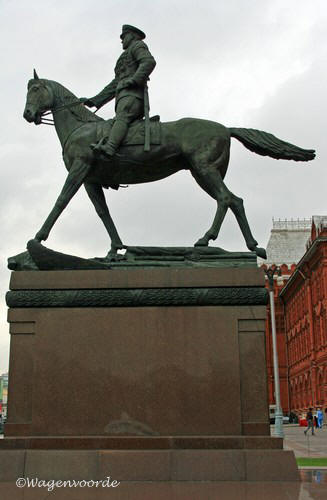
Zhukov
The monument of a commander, the first
Marshall of the Soviet Union — “The Marshall of Victory” Georgy
Konstantinovich Zhukov (1896—1974) was erected in front of the
Historical Museum at the Red Square in 1995 to commemorate the 50th
Victory anniversary in the Great Patriotic War of 1941—1945.
The sculpture is made by V.M. Klykov (1939—2006).
The five-meter-high bronze horse sculpture is mounted on the red granite
basement 100 t in weight. Zhukov appears to the public at the meridian
of his glory — at the review of the Victory Parade on June 24, 1945
when, sitting on a white horse, he greets the liberators. The image of
the victorious Marshall is associated with the image of St. George the
Victorious.
The American Commander-In-Chief General Dwight D. Eisenhower, when on a
visit to Moscow in summer of 1945 right after the Victory, claimed: “The
names of Zhukov and other Soviet commanders will be glorified in the
future as the names of the great professionals.”
Iberian Gate (Iverskie vorota) is the monument of Moscow medieval
architecture. Being built in 1534—1538 together with Kitaygorodskaya
Wall, they are the part of it (The Wall was built for the protection of
Kitay Gorog where mostly traders lived). 7 Gates were punctured at the
Kitay Gorod Wall. The most important and beautiful of them were Iberian
Gate (Iverskie vorota).
During its history the Gate was many times renamed: Kuretnye,
Neglimenskie, or Neglinenskie (as they were the passage from Kitay Gorod
to Neglinka), L’vinye (as near with them there were held lions in the
deep ditch, they were gifted to Tsar Ivan Grozny by the English Royal
Household), Triumfalnye. The Gage became Iverskie after the foundation
of the Chapel between them, where in 1669 was carried the exact list of
miracle-working Iversk Icon of the mother of God (the original is in
Afonsky Monastery).
The final (and modern) appearance the construction acquired in 1791,
when it was rebuilt.
Until 1820 there was the bridge cross Neglinka River before the Gate. On
that bridge people entered the Red Square through the Gate.
Everybody who entered the ancient Moscow, first of all went to the
Ivarskaya Chasovnya to bow unto the miracle-working icon.
The buildings of Historical Museum and State Duma were built at the
second half of XIX century at both sides of Iverskie Vorota.
Historical Iberian Gate (Iverskie vorota) was not preserved; they were
dismantled in 1931 within the period of the Red Square Reconstruction,
while they hindered the traffic and military technique transit on the
parades. Thus Moscow lost for so long time one of the most beautiful
sights.
However in 1995 the Moscow government decided to reconstruct the Iberian
Gate (Iverskie vorota) and Iverskaya Chasovnya (architected by O.I.
Zhurin).
The Zero kilometer of Russia was symbolically marked before the
Iverskaya Chasovnya, while actually in Russia it is counted from the
building of the Head Post office. Nowadays there are often people
tossing coins. Those who wish to come back here shall toss a coin so
that it falls into the middle of the notable sign and make a wish.
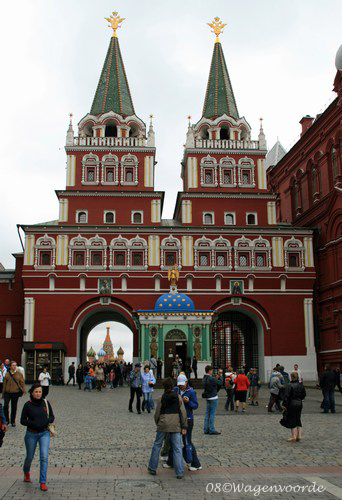
The Red Square
The major and most famous square of the Russian capital appeared in
Moscow at the end of the XV century during the reign of Ivan III. This
Moscow ruler who was the first to obtain the title of Grand Prince of
All Russia, was known for consolidation of the Russian lands, as well as
large-scale construction. To fulfill this Ivan III invited Italian and
Greek architects and gathered the best Russian ones: the intensive
reconstruction of the Kremlin started due to their efforts.
Then, in 1493 all the trading rows were removed outside the Kremlin
walls. Shops, stands and stalls filled every single spot at the bridges
over the moat along the Kremlin wall. The place was called “Market”. And
also “Fire” for shabby wooden sheds often caught fire and threatened the
Kremlin.
Soon the hand was put to the reconstruction of this posad. In 1534—1538
the whole territory thereof was walled around by Kitay-gorod defense
wall. Stone trading rows were arranged between the posad streets —
Nikolskaya, Ilyinka and Varvarka. Lobnoye Mesto (the Place of Skulls)
was built on the opposite of the Spasskaya Tower. It was mentioned first
in 1549 — when Ivan Vasilyevich the Terrible (1530 — 1584) asked the
Russian lands for forgiveness. At first this stand for tsar’s decrees
and religious ceremonies looked as a wooden platform. Then it was
reconstructed and became a stone one.
To the south thereof the Intercession Cathedral or the Intercession on
the Moat (that is more often mentioned by the name of the Moscow God’s
fool Vasili the Blessed — one side church thereof is devoted to him) was
erected. This nine-cupola church was laid according to the order of Ivan
the Terrible in 1554 to commemorate the victory over the Kazan Khanate.
In 1636 on the opposite side of the square, by the Voskresenskie Vorota
(Voskresensky Gates), the church of the Kazan Holy Mother of God
appeared to commemorate the rescue from the Polish interveners. It was
erected by the first tsar of the house of Romanovs — Mikhail Feodorovich.
The Kazan Cathedral was demolished in the Soviet times and restored in
1989.
The grand cathedrals transformed the square — it really became Red,
which means solemn and beautiful. This name was assigned to the square
by a special decree of 1688. Everything around the square including the
Kremlin towers and the Voskresenkie Vorota of Kitay-gorod started to
change to match the name.
In the XVII century solid administrative buildings appeared on the
square: grand mansions of the Zemskoy Prikaz were erected to the left of
the Voskresenkie Vorota, and a three-storey white-stone Mint — to the
right. The Main Apothecary was housed in the Zemskoy Prikaz soon, then,
for a while, the university founded by M.V. Lomonosov was located there.
Then the building was demolished. In August of 1875 the Historical
Museum (architect V. Shervud) was founded instead of it, in the
presence of tsar Alexander II and cesarevitch Alexander Alexandrovich.
In 1812 the Napoleon troops destroyed the square. It was restored
according to the project of O.I. Bove, as well as the whole of Moscow.
At the end of the XIX century the old trading rows were substituted by a
fashionable Passage (GUM (Main Department Store) today). In 1924 the
mausoleum (architect A. Shchusev) where the revolution leader V.I. Lenin
was buried was constructed on the square. At the Kremlin wall the
Necropolis was arranged, and fur trees were planted. The mausoleum was
adapted to serve as a tribune, and granite stands appeared on the both
sides thereof. The square became a place of ceremonial parades and
demonstrations.
Nowadays the Red Square is the favorite sight for the Muscovites and
guests of the capital, the real heart of Moscow.
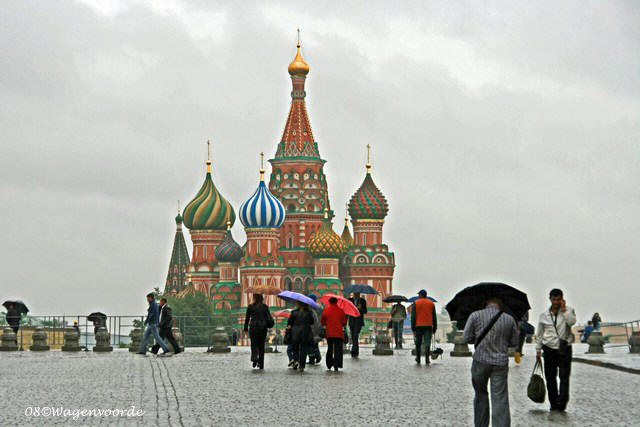
Lenin's mausoleum was designed by Alexei Shchusev in 1924, during a period in which the strength of the Russian Avant-Garde had not yet been decimated by Stalin's enforced return to heroic realism and conservative classicism. As a result, the founder of the Soviet state is blessed with a resting place that is a rare masterpiece of modern architectural simplicity. Faced with red granite (for Communism) and black labradorite (for mourning), the mausoleum is essentially a pyramid composed of cubes. Although the mausoleum has been stripped of the honor guard that once flanked its entrance, announced plans to remove Lenin's body seem to have lost their impetus in the last couple of years. The once lengthy line for admission has dropped off considerably, and a visit today is accompanied by a rather bizarre sense of having entered a place that has been forgotten by time. Lenin (or at the least the alleged wax copy of his body?) lies still in his crystal casket, seemingly unaffected by the vast changes that have swept over Russia.
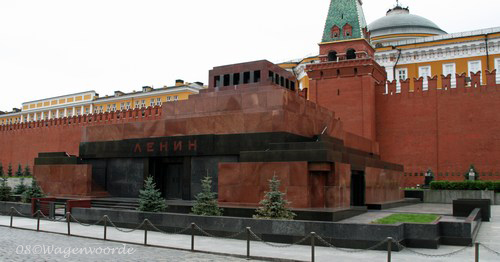
* * * * * * * * * * * * * *
* * * * * * * * * * * * * * * *
TOP * * * * * * * * * * * *
* * * * * * * * * * * * * * * * * * *
St. Basil's rises from Red Square in an irresistible profusion of colors and shapes. Its montage of domes, cupolas, arches, towers, and spires, each bearing a distinctive pattern and hue, have fascinated the eyes of visitors since its construction in the 1550s. Although St. Basil's was built to commemorate Ivan the Terrible's capture of the Mongol stronghold of Kazan and is properly named Cathedral of the Intercession, its popular name has long associated it with a ragged prophet who foretold the Moscow fire of 1547.
For centuries the palaces and churches of the Kremlin were the only buildings made of stone. The rest of the city was constructed of wood and was destroyed with each great fire (of which ancient Moscow had plenty). As a result, surviving artifacts of old Moscow are rare. They consist of major structures around the city and just a few wooden buildings hearty enough to survive the conflagrations.
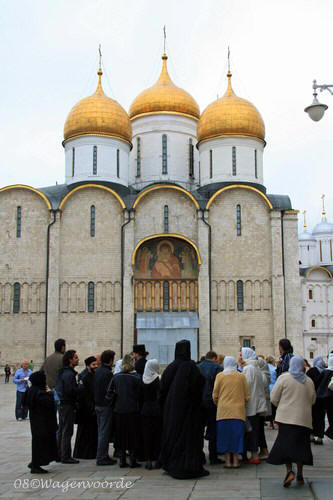
In the Kremlin, close to the 81 - meter tall Bell-Tower of Ivan the Great - once the highest building in Russia - the Tsar-Bell is on display, the largest bell in the world. Its weight is 202 tons and height 6.14 meters. It has never rung: soon after being founded it broke during a fire in 1737. A huge chunk which came off, lies next to it now. Not far from the bell, there is the 40-ton Tsar-Cannon - a masterpiece of the 16th century foundry - which also has never been used for its purpose.
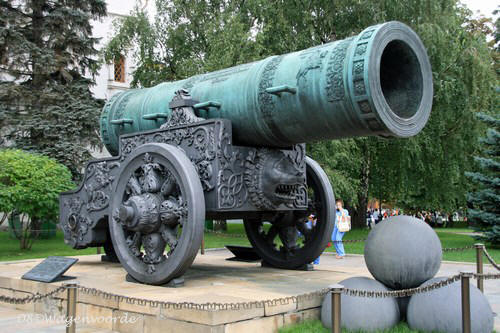
More cathedrals in Moscow:
http://www.cedargallery.nl/nlarchitectuur_gebouwen2.htm#russia
At the same time that Moscow's Kremlin was reinforced
as a protective citadel for the city center, a series of fortified
monasteries were constructed as an outlying defensive chain to the
south. The most famous of these is the beautiful Novodevichy
Convent, founded in 1524 and situated along a prominent bend in the
Moskva River. The convent's fame, however, has less to do with its role
as a protective fortress than with its aristocratic and political
history, for Novodevichy was the favored destination for high-ranking
women banished from court. The most famous inmate was Peter the Great's
elder sister Sofia, who had ruled as Regent during his minority. After
Peter came of age and--with some difficulty--claimed his throne, it was
to Novodevichy that he banished Sofia in 1689. Nine years later, as
Peter was returning to Russia after his travels in Europe, Sofia
engineered an attempted coup from the convent. The coup failed, and
Peter reached home in time to participate in the mass execution of the
rebels. Although Sofia was not to be harmed, she was apparently driven
mad when the bodies of her supporters were strung up outside her window.
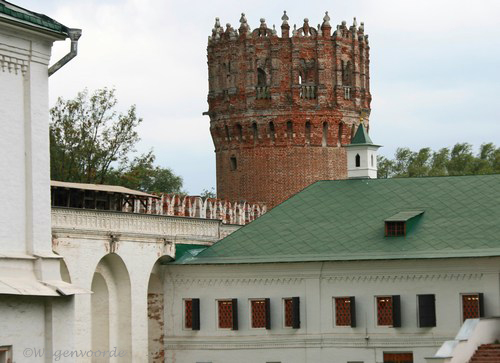
Novodevichy is also famous for the cemetery that lies beyond its south
wall. Here many famous writers, artists, and politicians are buried,
including Gogol, Checkov, Bulgakov, Mayakovsky, Stanislavsky,
Shostokovich, Eisenstein, and Nikita Khrushchev, the only Soviet leader
not buried behind Lenin's Mausoleum.
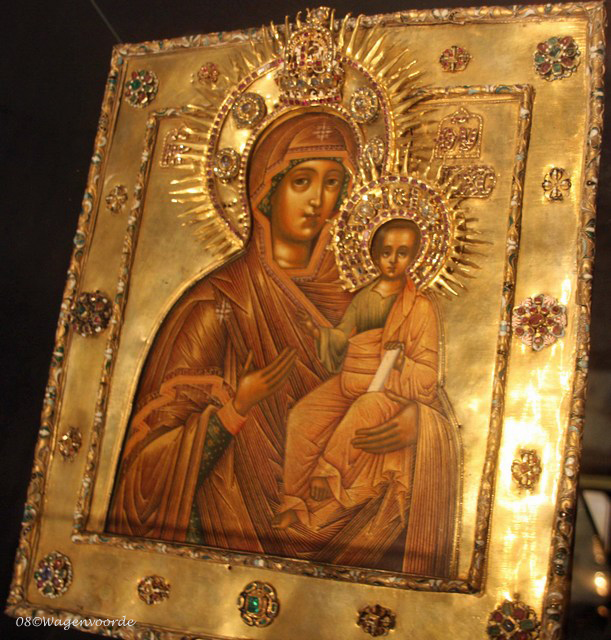
Manege
Before the Manege building appeared on the Manege Square this place had
various names — Beyond-the-Wall — for it was located beyond the Kremlin
Wall, Beyond-the-Neglinka — after the River of Neglinka, the
Moiseevksaya Square — after the name of the convent located there up to
the XVII century. After the Moscow University moved to the Mokhovaya
Street the square was called the Universitetskaya Square. In 1967 it was
called the 50th anniversary of October Square, and in 1990 the old name
— the Manege Square — was returned, for the Manege building and
Alexandrovskiy Sad (Alexander Garden) laid at the Kremlin walls (1823)
originally formed the architectural complex of the square.
It was built in 1817 to commemorate the 5th anniversary of the victory
over Napoleon. The facades in the Empire style were decorated by famous
architect Osip Bove. The erection meant for military parades and
military training exercises presented a real miracle (architect A.
Betankur, engineer L. Carbonnier). In the premises with the area over
6,000 square meters a regiment of 2,000 soldiers could maneuver
unchecked — there was not a single inner abutment under the huge roof.
Out of military parades hours the Manege was used for exhibitions, fairs
and concerts. Nowadays it is the largest exhibition hall of the capital.
The square in front of this building got the Manege Square name in 1931.
A large-scale reconstruction was carried out then. A whole block was
dismantled. The Obzhorny Tupik (Close) famous for its cheap food stalls,
Loskutny (Scrappy) Lane known for brisk fur and cloth trade and
Loskutnaya Inn famous in artistic circles disappeared then. The
underground construction commenced in the district. This section was
included in the first underground line — Okhotny Ryad Metro Station
opened on May 15, 1935.
Dramatic changes in the square look took place in the 1990s when a
large-scale underground retail complex “Okhotny Ryad” construction took
place. Zurab Tsereteli, President of the Russian Academy of Arts,
People’s Artist of Russia supervised the reconstruction of the square.
The famous maestro also created sculptures that decorate the fountain
complex “The Artificial River of Neglinka”. The fountains located at the
boundary between the Manege Square and Alexander Garden were erected to
the 850th anniversary of Moscow.
Several more sights separate the Manege Square from the Red Square.
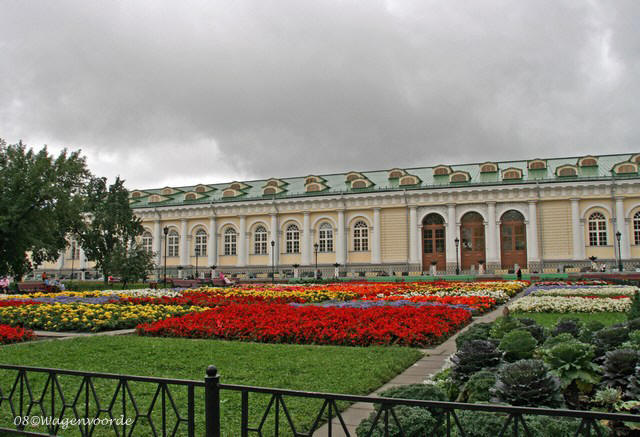
Metro
Moscow's grand metro stations, make
those of the great western capitals look tawdry in comparison. For New
Yorkers in particular, a visit to Moscow's metro induces severe station
envy. The first and still the finest of the Moscow metro stations were
the product of a Stalin's first Five-Year Plan. The system had begun in
1931, and the first line opened four years later.
Mayakovskaya Station, completed in 1938, features a central hall
supported by lovely stainless steel and red marble columns, which soar
up to a ceiling festooned with socialist realist mosaics. Other notable
stations include Ploshchad Revolyutsii, where the passageway arches are
supported by vivid sculptures of Red Army soldiers, and Kropotkinskaya
Station, with its elegantly-columned platform and upper galleries.
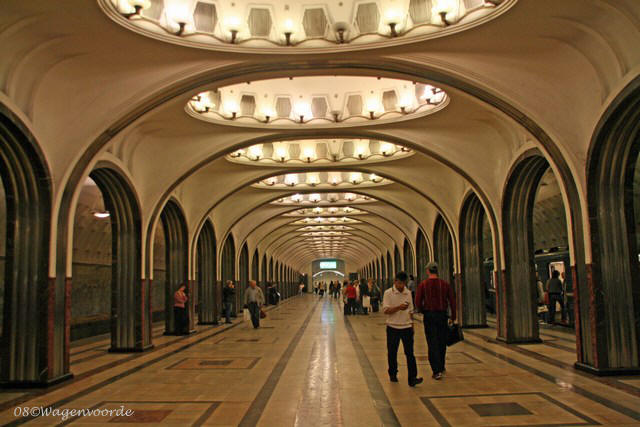
* * * * * * * * * * * * * *
* * * * * * * * * * * * * * * *
TOP * * * * * * * * * * * *
* * * * * * * * * * * * * * * * * * *
Arbat
It is one of the oldest and most well-known squares of the Russian
capital. The square changed its name only once: in 1909 Moscow held the
one hundredth anniversary of N.V. Gogol’s birth, a monument to the
writer was erected on Prechistenka, and Arbat was renamed into
Gogolevskaya Square. But the previous name that had been popularly known
for centuries was returned soon. Here, on the boundary of Bely Gorod and
Zemlyanoy Gorod lots of craftsmen slobodas and monastery lands were
located, merchants settled down. Merchants from eastern countries
brought an Arabic word “Arbat” that became the name of the street and
the square. The translation thereof is “suburb”.
The roads to Smolensk and Novgorod started at this square. Through the
Arbat Gates reigning tsars Vasili III, his son — Ivan Vasilyevich the
Terrible, and his son — Fyodor Ioannovich came back after their military
campaigns; people stopped there to pray. At the gates — to the opposite
of the contemporary Vozdvizhenka Street — the Saints Boris and Gleb
Church had been located since the XV century. It was demolished in 1930
and restored in summer of 1997. Unfortunately, the size and structure of
the new square did not allow to restore the church according to its
original structure and at the original place. Nowadays the Saints Boris
and Gleb Chapel is located at the place of another Arbat church — that
of Tikhon Amafuntsky the Sanctifier known since 1620, that was also
demolished in 1930.
In those years, in the 30s, several efforts were made to clear up and
asphalt the whole square. The rampant had not been there for a long time
already: it lost its defense significance in the middle of the XVIII
century. The bricks of the rampant were used while erecting public
buildings. The wooden buildings were gradually substituted by stone
houses. Luxurious mansions belonging to Moscow grand people, hotels,
restaurants, shops and a theatre were situated in the district. At the
beginning of the XIX century the contemporary boulevards — Gogolevsky
and Nikitsky — appeared on the opposite sides of the square, and a
horse-tram line was laid along Arbat; at the beginning of the XX century
a tram line was laid. On May 15, 1935, the overground entrance hall of
the Arbatskaya Metro Station(architect L.S. Teplitskiy) was opened: an
unusual building in the form of a five-point star reflected the
atmosphere of that time. Grey houses built in the constructivism style
that replaced the patrician Arbat mansions with attics preserved the
traces of the proletary austerity.
After a large-scale reconstruction, the transport tunnel erection in
1964 and transformation of the Arbat Street into a pedestrian one in
1985 the square lost practically all historical buildings. Only the
building of Khudozhestvenny Cinema (it was among the first cinemas in
the capital, A.A. Khanzhonkov opened it in 1909) and Praga Restaurant
are an exception. The history of the latter is interesting enough. In
1899 some adventurous merchant Semen Tatarykin bought out a corner house
the ground floor of which hosted a tavern already, ordered the overall
reconstruction of the building at the fashionable Moscow architects Lev
Kekushev and Adolph Erichson and opened a first-class cuisine restaurant
in sophisticated interiors. After the 1917 revolution a “Mosselprom” — a
well known Moscow food organization — public dining hall was opened in
the Praga Restaurant. Mosselprom House (architect D. Kogan) called the
first Soviet sky-scraper was built nearby in the Kalashny Lane in 1923.
The house was famous for its ingenious mural made on an unplastered
wall: it contains advertisements of sweets, milk and beer, as well as
the famous slogan by poet Vladimir Mayakovsky that is often recollected
nowadays — “Nowhere except Mosselprom”.
The monument to the Emperor Peter I
(1672—1725) was opened in the Russian capital in 1997 during the
celebration of the 850th anniversary of Moscow. The formal name of the
monument is the “Monument in Commemoration of the 300th Anniversary of
the Russian Fleet”. The author is a famous Russian sculptor Zurab
Tsereteli.
This is one of the highest sculptural monuments in the world and the
highest monument in Russia with the overall height of about 100 m. The
monument is made of bronze, stainless steel, copper coated with wax and
lacquer, protecting it in any weather.
On a high pillarlike base there is a bronze ship — a symbol of Russia,
abaft the wheel there stands the Emperor Peter the Great with a map in
his hand. Fountains are constantly playing in the reinforced-concrete
base, thus creating an illusion of movement of the big ship.
Technically, the monument is a complex structure: the bottom part of the
monument, the ship and Peter’s figure were assembled individually and
then, ready fabricated, were mounted to the base. For the purposes of
weight saving, inside the sails there is a spatial metal frame. Flags on
the ship are designed as weathervanes; St. Andrew’s Crosses on the flags
are gold plated, just like the scroll which the Emperor Peter holds in
his hand.
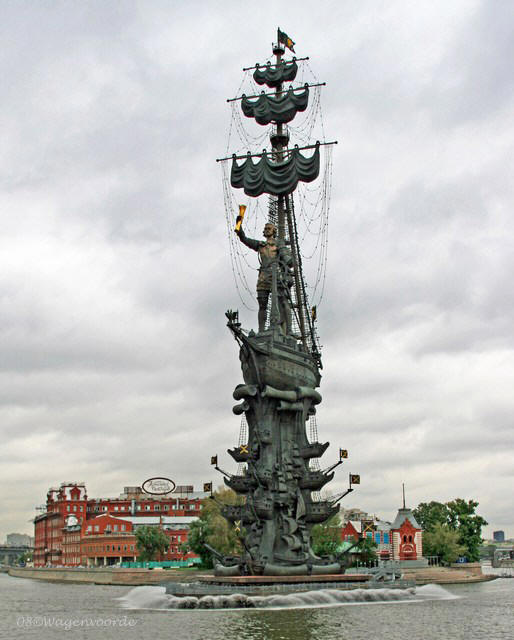
The Cathedral of Christ the Saviour, the
largest of the Russian Orthodox Church, can accommodate up to 10,000
people. Horizontally, it has been designed in the form of an equilateral
cross over 85 meters wide. The building`s total height is 103 meters,
while the dome and the cross alone make up 35 meters. The walls are up
to 3.2 meters thick, and the total space of the structure is 542,000
cubic meters. Over 22,000 cubic meters are covered in paintings, with
over 9,000 cubic meters of the total in gold leaf gilding. The cathedral
of the Russian Orthodox Church is an identical replica of the shrine
originally erected in the 19th century and demolished in the 20th
century.
The cathedral was conceived as a monument to the incredible bravery the
Russian people showed in their struggle against Napoleon`s army in 1812.
The cathedral was financed with donations from the public. The building
was so great, and the work so expensive, that the construction was drawn
out for decades, and the cathedral was not consecrated until April 10,
1883 just in time for the coronation of Alexander III.
The final architectural design was authored by Konstantin Ton. He
devised a five-domed cathedral in the Neo-Byzantine style, with a great
central bell tower and four more smaller ones set diagonally at angles.
The lower was decorated with 177 marble plates that detail the
chronicles of the Patriotic War of 1812. The trophy banners and keys to
conquered cities were also kept in the cathedral. The artists hired to
paint the interior walls and icons included such famous masters as
Vasily Surikov, Viktor Vasnetsov, Ivan Kramskoi, and Vasily
Vereshchagin.
In place of the traditional massive Russian iconostasis, the cathedral
featured an octahedral chapel of white Italian marble with the altar in
the center. To provide enough light for the cathedral, some 640
chandeliers were mounted in the dome, with 600 more peripheral
chandeliers on the choir loft. The first electrical torches in Moscow
were installed on the square in front of the cathedral. And Professor
Mikhail Spassky of Moscow University designed a special system of
lightning conductors.
For all its national significance, however, the people`s monument was
pulled down in 1930 and it was decided to build the Palace of Soviets in
its place. The palace never came to fruition though. Later on, the open
foundation pit was used to build the open-air swimming pool Moskva,
which was commissioned in 1960. The pool measured over 130 meters in
diameter, with a maximum depth of 6 meters. In 1994, the swimming pool
was closed, and in 1995, the ceremony of laying the foundation for the
cathedral to soon be restored was held.
The Cathedral of Christ the Saviour was restored in just about every
minute detail. Unlike the original cathedral, the new one now has a
basement which houses the Transfiguration Church, the premises of the
Holy Synod and the Ecclesiastical Academy, a hall for meetings of the
Church Council, and a number of other premises. An observation platform
was also installed at the bell tower level.
The cathedral was consecrated in the run-up to Christmas in 2000, and
the first service was held on December 31, 1999.
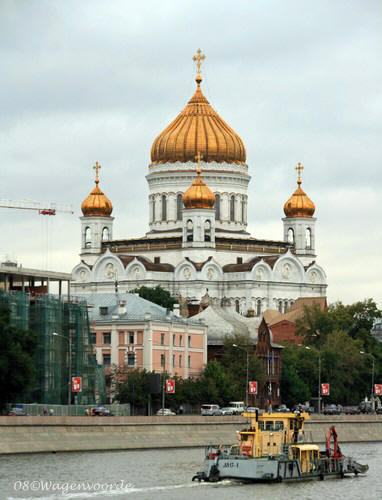
The Pushkin State Museum of Fine Arts
The State A.S. Pushkin Museum is the first museum in Moscow that is
dedicated to the life and the creativity work of the famous Russian poet
Alexander Sergeevich Pushkin. The museum complex was founded in 1957 on
the territory of the former urban mansion belonged to the family
Khruschev-Selezniov on the street Prechistenka 12/2. After its
reconstruction and restoration in 1997 it became a modern
multifunctional cultural center with 300 visitors annually. In the halls
of the main mansion building the exposition "Pushkin and his epoch" is
situated. The collection of the museum numbers more than 165 thousands
of museum items (including items from the scientific-subsidiary fund).
Art works of world significance, for example, works of Tropinin,
Kiprensky, Brullov, Petrov-Vodkin, Korovin and others of the 19 - 20th
centuries are displayed there.
The system of open storage is developed in the State A.S.Pushkin Museum.
Annually the museum implements about dozens of exhibition projects,
holds about 100 concert programmes, literary lecturing, international
scientific conferences and seminars. One of its particular activities is
the work with children audience. There are a lot of interactive
programmes, membership tickets, theatrical and museum projects, New Year
balls for children.
The State A.S.Pushkin Museum has several affiliates: A.S.Pushkin
Memorial Apartment in Arbat Street (Arbat str., 53), Andrey Beliy
Memorial Apartment (Arbat str., 55), memorial I.S. Turgenev
House-Museum (Ostozhenka str., 37), etc. The museum complex also
includes exhibition halls on Arbat street, where exhibitions of modern
artists are held.
The Gallery of 19th and 20th century European and
American Art opened its doors to the public in Ausust 2006.
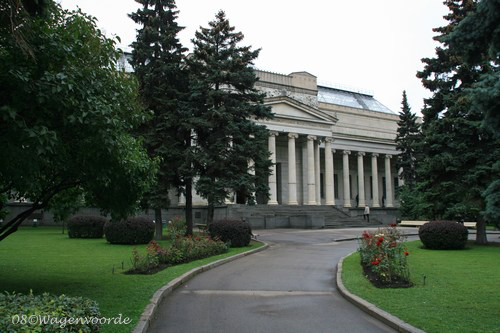
Volkhonka 14 where this Gallery is located was originally the left wing
of an estate belonging to the Golitsyns. Here, in the main house of the
estate, Prince M.A. Golitsyn’s picture gallery and collection of
‘antique rarities’was opened to the public.
The general plan of the estate with the main house, side wings and front
courtyard has survoived, although all the buildings have been regquently
rebuilt. Vasily Surikov, Ilya Repin, Alexander Scriabin and Leonid
Psasternak stayed or lived here for a long time.
In 1888-1993 the building, now part of the Pushkin Museum, underwent
full scale reconstruction.
The pride of the Gallery consists of the paintings by French
Impressionists and Post-Impressionists and masters of the early 20th
century, like Claude Monet, August Renoir, Edgar Degas, Paul Gauguin and
Vincent van Gogh.
There are also works of Vasily Kandinsky, Marc Chagall, and sculptors
as Auguste Rodin and Ossip Zadkine are also represented.


Henri Matisse and
Henri Rousseau
The Tretyakov Art Gallery in
Zamoskvoretsje area is a Russian fine
arts museum of the X-XX centuries. It was named after its founder,
merchant and patron of arts Pavel Tretyakov who in 1892 granted his
collection to Moscow. At that time the main part of the collection were
pictures by «Peredvizhniki» ( "The Society for circulating art
exhibitions - Traveling artists") - painters of democratic trend in art.
In the museum one can see such masterpieces as the Icon «Troitsa»
(«Trinity») by Andrey Rublev (XV century), the great canvas «Christophany»
by Alexander Ivanov, llya Repin's «Ivan the Terrible and his Son lvan»
depicting the horror of the father who has killed his son, historical
canvases by Vasily Surikhov, works of art by Russian avant-gardists
Malevich, Kandinsky, Rodchenko, Larionov, Goncharova etc.
The Moscow School of Management, Skolkovo
In Russia, a business school flouts the traditional
buildings-around-a-green campus organization in favor of a more
winter-friendly megastructure.
In the icy outskirts of Moscow lies a massive new
complex: one part academic institution, one part alien mother ship.
Designed by London- and Berlin-based Adjaye Associates, the Moscow
School of Management, Skolkovo, is a 460,000-square-foot mega structure
that contains all the usual facets of campus life—classrooms, lecture
halls, a cafeteria, and a 660-seat auditorium, among others—in a series
of interconnected buildings. In 2006, in conjunction with a state-led,
Vladimir Putin–endorsed push to make Moscow a prominent center of world
trade, a contingent of Russia’s wealthiest businessmen—including magnate
Roman Abramovich, the world’s 53rd richest person—launched the
initiative to establish Skolkovo. Four years and $250 million later, a
new university had risen.
The central structure is a concrete disc 475 feet in
diameter that houses academic and recreational facilities. Entrances and
parking are tucked beneath the disc on the ground level, allowing
visitors to avoid the cold by driving into a garage-like enclosure. The
customary campus green, fine for more temperate climates, is replaced at
Skolkovo by “teaching units” that are used for informal gathering and
exhibiting student work. Four boxy volumes of varying sizes, clad in a
mosaic of colored aluminum-composite panels, sit atop this base.
For pictures and further information, click on the link below.Abou
http://www.archdaily.com/214178/moscow-school-of-management-adjaye-associates-ab-studios/
'The Worker and the Kolkhoznitsa (woman collective farmer)' is a sculptural group created by Vera Mukhina for the Soviet pavilion at the International exhibition in Paris in 1937. It has been placed before the Northern entrance of the All-Russia Exhibitional Center. It is cast of stainless steel; its height is about 25 m. It is a typical work of socialist realism symbolizing the unity of the working class and the peasants: the worker and the «kolkhoznitsa» are holding a sickle and a hammer above their heads; those are symbols of the Soviet state.
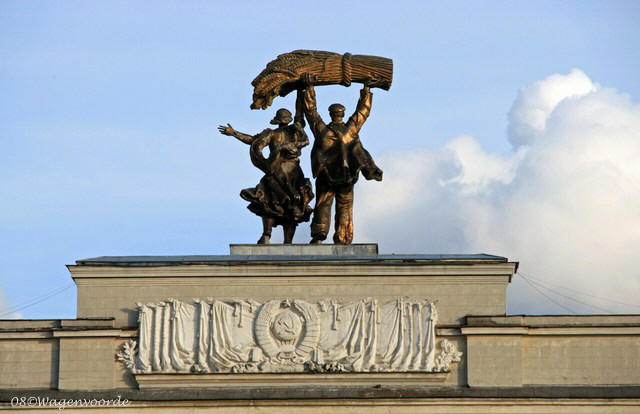
* * * * * * * * * * * * * *
* * * * * * * * * * * * * * * *
TOP * * * * * * * * * * * *
* * * * * * * * * * * * * * * * * * *
Our website, and certainly the section about Russia,
is a labour of love.
Several books are written, several websites created about this
immense country.
Nevertheless we hope that our visitors enjoy what they find and read
here.
This section is just a modest tribute to the beauty of Moscow.
Used and adviced literature:
Russia - Jonathan Dimbleby
Moscow - Yakov Belitsky
Moscow (Lonely Planet) - Mara Vorhees, Leonid Ragozin
Gallery of 19th and 20th century European and American Art, gallery
guide
websites:
http://www.encyclopedia.com/topic/Moscow.aspx
http://www.rnvb.nl/Moscow_and_the_Moscow_Region.phtml
Texts, pictures,
etc. are the property of their respective owners.
Cedar Gallery is a non-profit site. All works and articles are published
on this site purely for educational reasons, for the purpose of
information and with good intentions. If the legal representatives ask
us to remove a text or picture from the site, this will be done
immediately. We guarantee to fulfill such demands within 72 hours.
(Cedar Gallery reserves the right to investigate whether the person
submitting that demand is authorized to do so or not).
The contents of this website (texts, pictures and other material) are protected by copyright. You are welcome to visit the site and enjoy it, but you are not allowed to use it, copy it, spread it. If you like to use a picture or text, first send your request to
* * * * * * * * * * * * * *
* * * * * * * * * * * * * * * *
TOP * * * * * * * * * * * *
* * * * * * * * * * * * * * * * * * *